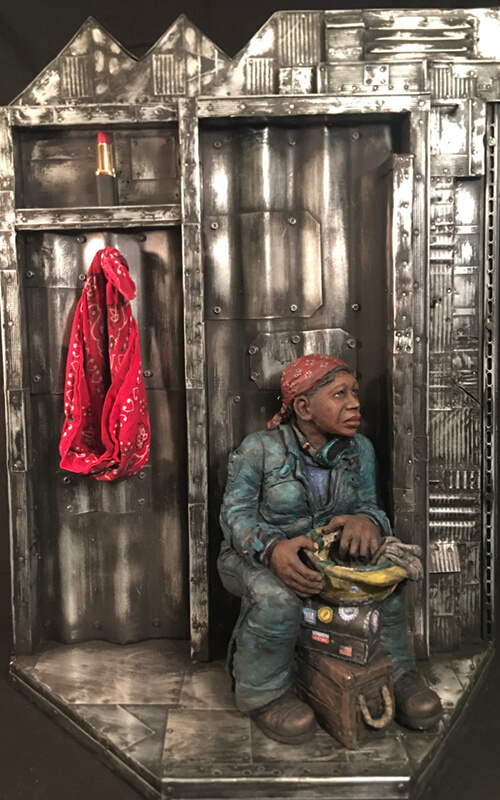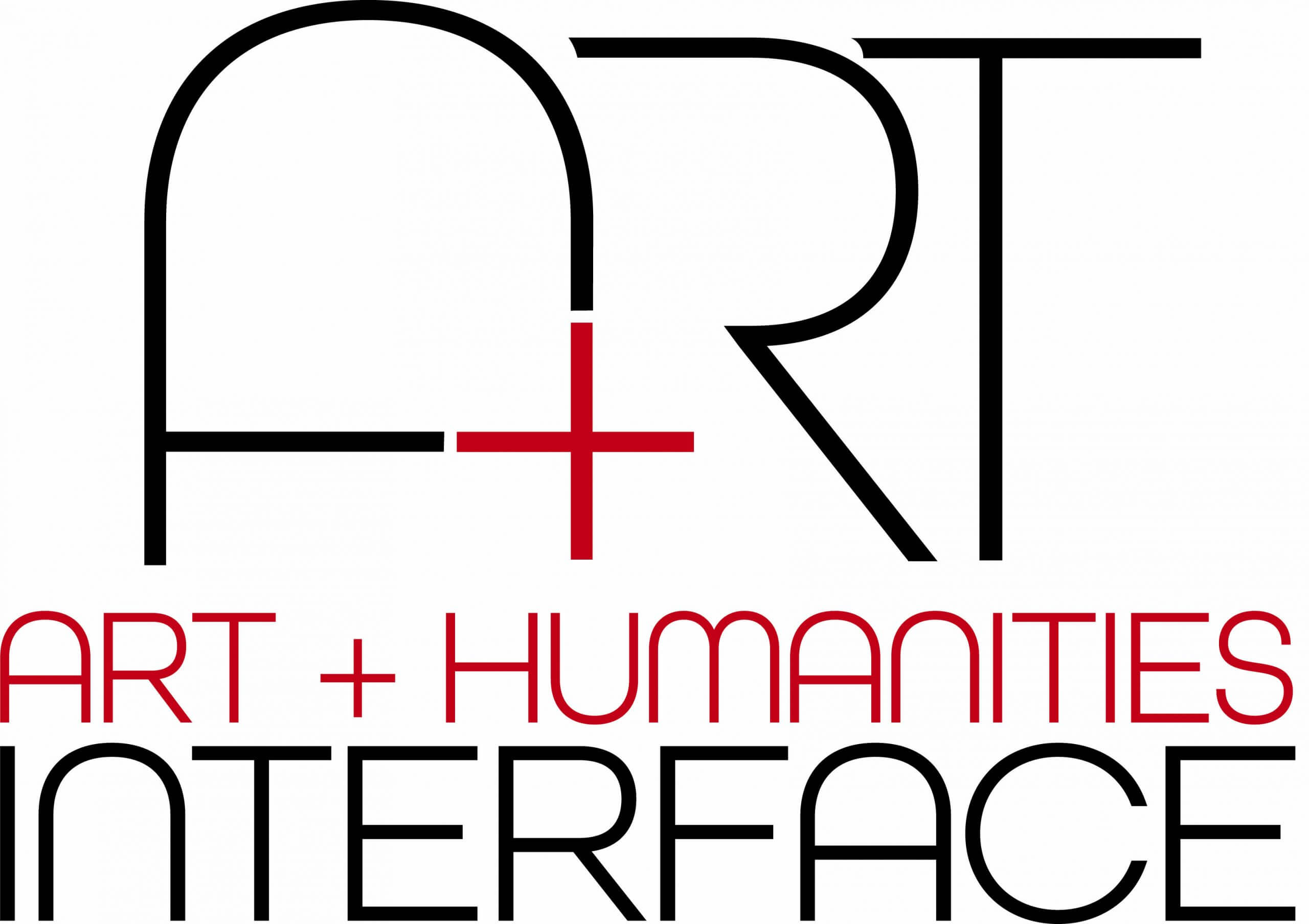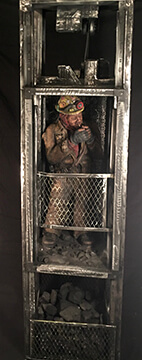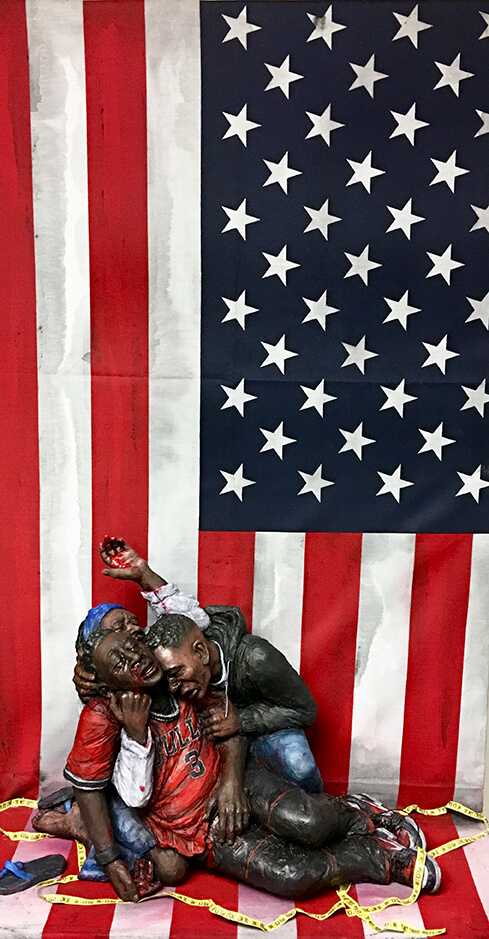Kyle & Kelly Phelps: On(c)es Forgotten
Posted Nov 01, 2020
August 26 – December 4, 2020
Reception: Thursday, October 22, 2020; 5 – 7p
Updates and reception sign-up: here or contact 614.823.1792
How are people made visible in our communities, our country, and our world? What gives people voice and makes them feel heard when they historically have been ignored, left behind, or oppressed? The On(c)es Forgotten exhibition asks such questions through the expressive realism of Kyle and Kelly Phelps’ ceramic mixed media art. It acknowledges the 2017 watershed of social justice movements in the United States, when issues of marginalized and disempowered communities became visible in mainstream narratives and were amplified further by the COVID-19 pandemic in Spring 2020. The exhibition brings into conversation Phelps’ familiar images of blue collar, industrial, rural working class men and women with those of urban African-Americas struggling against inequality and oppressive systems. This juxtaposition challenges pervasive storylines that place rural and urban communities in binary opposition. Phelps’ large-scale, wall-mounted pieces are powerfully engaging and replete with nuance and intelligent details that engage the viewer in a conversation about our nation’s complex history.
Join Kyle & Kelly Phelps for a zoom webinar on Monday, September 21, 7 – 8p EST
Location and Hours
The Frank Museum of Art
39 S. Vine Street
Westerville, OH 43081
W - Su 11 a.m. - 3 p.m.
Closed Holidays and Breaks
614-818-9716
All exhibitions are free
and open to the public.

 |
 |
Reflections on Labor and the On(c)es Forgotten Exhibition
Kyle & Kelly Phelps, artists
Anthony DeStefanis, PhD
Associate Professor of History
Otterbein University
The Industrial Revolution in the United States hinged on coal mining and steel production. Coal was necessary for making steel, and steel was necessary for making everything else: railroad track, locomotives and railroad cars, steel frames for skyscrapers, factory machinery, automobiles, trucks, airplanes, and so much more. Yet in this time of explosive economic growth, coalminers and steelworkers lived in poverty. From the 1870s—when industrialization began to take off in the U.S.—though the 1930s, coal miners and steel workers toiled for twelve hours a day, six or seven days a week, in working conditions that were unconscionably dangerous. Death tolls in the coal and steel industries escalated due to on-the-job mine explosions, cave-ins, and steel furnace explosions, as industry managers and engineers learned how to mine deeper and make steel on a mass scale. Miners and steel workers were guinea pigs in this process, which took place over several decades and killed or physically maimed thousands of men. Losing male breadwinners to injury or the grave was devastating for working-class families. Working-class married women already often worked for a wage outside the home, and the loss of a spouse forced them to get more than one job and take their adolescent children out of school and send them to work.
Working-class people of a century ago were often trapped by their working lives. Laboring for so many hours most days of the week for meager wages meant that these workers had little time to enjoy other pursuits or even spend time with their families. Receiving so little money for such demanding and dangerous work also meant that they were without possibility to further their own education or to send their children to college. Instead, it was often the case in the late nineteenth and early twentieth centuries that the children of industrial workers went to work as young as twelve or thirteen years old, because their families needed the additional income to survive. The industrial laborers portrayed in the On(c)es Forgotten exhibition that features the artwork of Kyle and Kelly Phelps are steelworkers and miners—working class men and women portrayed as overworked and exhausted, the physical characteristics of these trades. The metal and wooden settings, reclaimed scraps from now abandoned industrial sites, provide context for the figures. Some of these settings convey the oppressive, enclosed spaces in which the industrial working class spent the majority of their adult lives. For example, in Miners Shrine, a dust-covered miner stands in a narrow elevator shaft barely the width and depth of his uniformed body. The artists convey the depths of the worker’s journey down into the mines by making the enclosure four times longer than its width. The figure lights a cigarette, suggesting a much needed, but ‘on-the-job’, break. There is little reprieve, even for his dust coated lungs. Kentucky coal, known for its higher sulfur content, fills the opening below the miner’s feet in this mixed media work.
The figures in several pieces are shown kneeling and/or bowing their heads. These portrayals recall the dignity of these women and men, who often took up their faith as a way of resisting their oppression. Biblical passages, such as Ephesians 4:28, often helped the working class face their difficult lives: “Anyone who has been stealing must steal no longer, but must work, doing something useful with their own hands, that they may have something to share with those in need.” In our contemporary situation as we live with the burden of Covid-19, the plight of low-wage workers who have been deemed essential can be called to mind. Like the miners and steelworkers of a century ago who made the industrial revolution possible, grocery store workers, warehouse workers, farm workers, home healthcare workers, retail store workers, and others make it possible for Americans to feed themselves and even flourish. During our current global pandemic, one on the scale not seen since the early 20th century, these essential workers take their lives into their hands everyday as they make sacrifices similar to those of the miners and steelworkers of a century ago, workers who they toiled through the 1918 influenza pandemic, many falling ill and dying.
The workers’ hope for a better life that we see across the faces portrayed in Kyle and Kelly’s sculptures was eventually realized through the enormously successful union organizing campaigns that Franklin Roosevelt’s New Deal helped launch during the 1930s. Unionization made mining and steelmaking much safer and turned these jobs into ones that paid a middle-class wage. Workers fought hard for these changes, and they were often able to come together across racial and ethnic lines to speak with one voice for their interests as workers. Today, we are seeing a reckoning with this country’s racial past, poignant in works like Justice or just us. The challenging conditions that workers, many of whom are black and brown, deal with every day as they risk their lives to keep the American economy functioning, must be addressed, alongside racial issues. We can look to the past for inspiration and example, making nuanced and relevant adjustments in our contemporary situation.
References
Bell, Thomas. Out of this Furnace: A Novel of Immigrant Labor in America. University of Pittsburgh Press, 1941, 1976.
Green, James. The Devil Is Here in These Hills: West Virginia’s Coal Miners and Their Battle for Freedom. New York: Atlantic Monthly Press, 2015.
Krause, Paul. The Battle For Homestead, 1880-1892: Politics, Culture, and Steel. Pittsburgh, PA: University of Pittsburgh Press, 1992.
Rosenow, Michael. Death and Dying in the Working Class, 1865-1920. Urbana, Illinois: The University of Illinois Press, 2015.
Zeiger, Robert. The CIO, 1935-1955. Chapel Hill, NC: University of North Carolina Press, 1996.


Miners Shrine, 2020 Injustice or just us, 2018